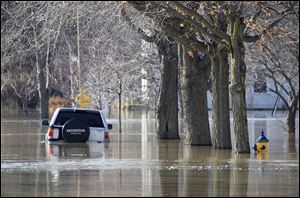
FINDLAY
Blanchard flood-aid plan gains traction
Project aims to be less intrusive to farmers
8/10/2013
A Blanchard River flood-mitigation plan that will cost more but be less intrusive to farmers has been identified by area officials as the one they want the Army Corps of Engineers to eventually approve.
FINDLAY — A Blanchard River flood-mitigation plan that will cost more but be less intrusive to farmers has been identified by area officials as the one they want the Army Corps of Engineers to eventually approve.
Brian J. Robertson, a Hancock County commissioner who led a series of meetings last week between a five-member northwest Ohio delegation and staff members at the Corps’ Buffalo district office, said Friday the top priority is a plan that calls for a major deepening and widening of a channel west of Findlay known as Aurand Run. Additional meetings are scheduled for the last week of August in Columbus among state, federal, and local officials.
If the Corps approves the plan, the engineering study is expected to be completed in 2015. That, Mr. Robertson said, would keep the project on its most recent timetable, which has called for work to begin in 2017 — a decade after a 2007 flood cost Findlay $100 million in damage and cost Ottawa, Ohio, $20 million.
Construction is expected to take years to complete.
A hearing is planned for October to unveil the preferred alternative to the public, Mr. Robertson said.
“We’re in the home stretch here, and we need to follow this to make sure there aren’t any pitfalls,” he said.
It is unknown how much more the preferred option would cost. Any successful plan is expected to require a massive re-engineering of northwest Ohio’s water system between Findlay and Ottawa. The water-control work has been estimated to cost as much as $150 million.
The Corps has agreed to pay 65 percent of the cost for what would be the cheapest alternative. The remaining 35 percent and all other costs are to be covered by revenue from a countywide tax voters approved in 2009, Mr. Robertson said.
“Too many times political leaders take the path of least [funding] resistance. The Corps was doing that,” Mr. Robertson said.
The option put forth by the local delegation is “definitely not the path of least resistance, but it’s best for us,” he said.
Assuming there’s enough money, officials have decided to pursue an option that will likely be more expensive because they believe it will make life easier for everyone in the long run, he said.
Several farmers have been following the process, concerned about how any new channels or ditches could affect their operations.
Officials said some sort of water diversion is inevitable, and the most logical approach would be with Aurand Run because it is an existing stream, Mr. Robertson said. “It’s a known entity,” he said.
Besides Mr. Robertson, the local delegation that met with Corps staffers in Buffalo included Steve Wilson, project manager; Paul Schmelzer, Findlay's service-safety director; J. Dean Meyer, Ottawa’s mayor, and Jason Phillips, Ottawa’s water director.
Requests for information were referred to Mr. Robertson.
Bruce Sanders, a Corps of Engineers spokesman, issued a statement that acknowledged this week’s meetings but did not discuss the preferred alternative identified by the Findlay and Ottawa representatives.
Contact Tom Henry at: thenry@theblade.com or 419-724-6079.